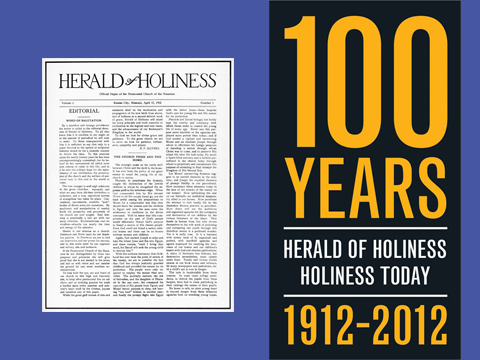Remembrance of Things Past

I borrowed the title from Marcel Proust's seven-volume novel. A very old classic work it is, its first volume being published in 1913. But Holiness Today, and its predecessor, the Herald of Holiness, are older. The first edition of the Herald hit mail boxes in 1912.
Proust finished his seventh volume of Remembrance of Things Past in 1922, about the time the Herald was hitting high gear.
After the Wesleyan Revival in 18th-century England splashed onto the shores of the U.S. and helped launch the Holiness Movement, the Herald was there to chronicle the Holiness Revival in general and the Church of the Nazarene in particular.
It is hard to exaggerate the positive role of the Herald in the early decades of our denomination's history.
Every pastor and district superintendent was a promoter of the Herald. Evangelists not only reported the number of seekers ("counting as they came") but they also reported the number of Herald subscriptions they sold during the revival. Every convert was told, in one way or another, "Now you are a part of our church, you must have our church paper, too."
The Herald enjoyed near-sacred status among many. My parents read every line. In my first pastorate a faithful Nazarene phoned to ask, "Is it a sin to throw away old copies of the Herald?" She had been saving them for 20 years and was running out of space.
Holiness Today and the Herald of Holiness have served us in many ways during the past 100 years.
1. Framer of the Heritage
The mission statement of the magazine, stated in one form or another, has always included the idea, "be faithful to the heritage and relevant to the times."
Today more "isms" are blowing in the wind than when Marco Polo hiked east, or when Columbus sailed west, or even when Peter, Paul, and Mary first belted out "Blowin' in the Wind." Buddhists and Baptists, Catholics and Muslims, Mormons and Methodists, Jews and Jehovah's Witnesses, Hindus and Presbyterians, Scientologists and Santeros, Atheists, and Adventists mix in the same neighborhoods, schools, and supermarkets.
With so many dust devils swirling in the spiritual atmosphere, we need the foundation of our faith heritage more than ever. Some think that they can figure it all out by themselves in their free time, so they feel no debt to those who blazed the trails on which they bike and picnic. But most of us appreciate the "place to stand" provided by our Christian, Protestant, Wesleyan-Arminian, Holiness Movement, and Nazarene heritage. A heritage that Holiness Today and the Herald of Holiness have vigorously supported for a century now.
2. The Glue That Holds the Nazarene Family Together
The Nazarene family is quite a phenomenon. It has been my privilege to do church work in about a dozen countries. In every one of them I was greeted like a long lost uncle, a returning son, a treasured family member. Everywhere I went, I sensed the kinship of Nazarenes, a bond that transcends culture and race. If they find out you are a Nazarene, a spontaneous empathy springs up. Indeed, our church is a called-out covenant community, and the Herald and Holiness Today have had a vital part in producing the "glue" that holds us together.
One reader wrote, "Every issue of the Herald is like getting a letter from home."
3. A Spiritual Resource Packet
When I was growing up, my parents read the Herald religiously as they sought to live a holy life and teach a family of seven. Perhaps that is why during my tenure as editor I made sure that every issue had at least one article on Bible study, prayer, and spiritual formation. We started with the columns, "Into the Word, "When You Pray," and "Rhythms of the Spirit."
None of the editors in our 100 years of history have settled for merely filling the pages with sentimental drivel, folk theology, or ranting jeremiads. No, we all wanted the Herald and Holiness Today to be a spiritual resource packet for those truly concerned about holy living.
4. A Christlike Shape to the Years Ahead
If William R. Inge was right, there is no greater disloyalty to the pioneers than to refuse to budge an inch from where they stood. Thus, the remembrance of things past in the Herald and Holiness Today story is not a hitching post for nostalgia, but a guidepost for tomorrow that beckons with promise.
True to our Wesleyan-Arminian heritage, we believe that God has made us partners in creativity with Him. The future can be more than some mysterious realm beyond the rim of tomorrow. At some levels, the future is subject to creation.
The future is not going to be all wood pulp and printer's ink. We know that, and that's why Holiness Today communicates the concerns of Christian holiness through a variety of Web-based media, including Facebook and Twitter. Whatever means and methods are required, the Church of the Nazarene and Holiness Today are committed to giving a Christlike shape to the years that are about to be.
Facebook: http://www.facebook.com/holinesstoday
Twitter: https://twitter.com/HolinessToday
Holding the treasure of the past in one hand and the promise of the future in the other, this remembrance of things past can take on the glow of the title of Proust's seventh volume of his novel, Time Regained. Let us pray at this century post that Holiness Today has more future than past.
Wes Tracy taught Christian preaching and adult education at Nazarene Theological Seminary. He has also served as editor of the Herald of Holiness and Preacher's Magazine.
Holiness Today, March/April 2012
Please note: This article was originally published in 2012. All facts, figures, and titles were accurate to the best of our knowledge at that time but may have since changed.




